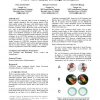Free Online Productivity Tools
i2Speak
i2Symbol
i2OCR
iTex2Img
iWeb2Print
iWeb2Shot
i2Type
iPdf2Split
iPdf2Merge
i2Bopomofo
i2Arabic
i2Style
i2Image
i2PDF
iLatex2Rtf
Sci2ools
WWW
2009
ACM
2009
ACM
What's up CAPTCHA?: a CAPTCHA based on image orientation
We present a new CAPTCHA which is based on identifying an image's upright orientation. This task requires analysis of the often complex contents of an image, a task which humans usually perform well and machines generally do not. Given a large repository of images, such as those from a web search result, we use a suite of automated orientation detectors to prune those images that can be automatically set upright easily. We then apply a social feedback mechanism to verify that the remaining images have a human-recognizable upright orientation. The main advantages of our CAPTCHA technique over the traditional text recognition techniques are that it is language-independent, does not require text-entry (e.g. for a mobile device), and employs another domain for CAPTCHA generation beyond character obfuscation. This CAPTCHA lends itself to rapid implementation and has an almost limitless supply of images. We conducted extensive experiments to measure the viability of this technique. Cat...
CAPTCHA Generation | CAPTCHA Technique | Human-recognizable Upright Orientation | Internet Technology | WWW 2009 |
| Added | 21 Nov 2009 |
| Updated | 21 Nov 2009 |
| Type | Conference |
| Year | 2009 |
| Where | WWW |
| Authors | Rich Gossweiler, Maryam Kamvar, Shumeet Baluja |
Comments (0)

